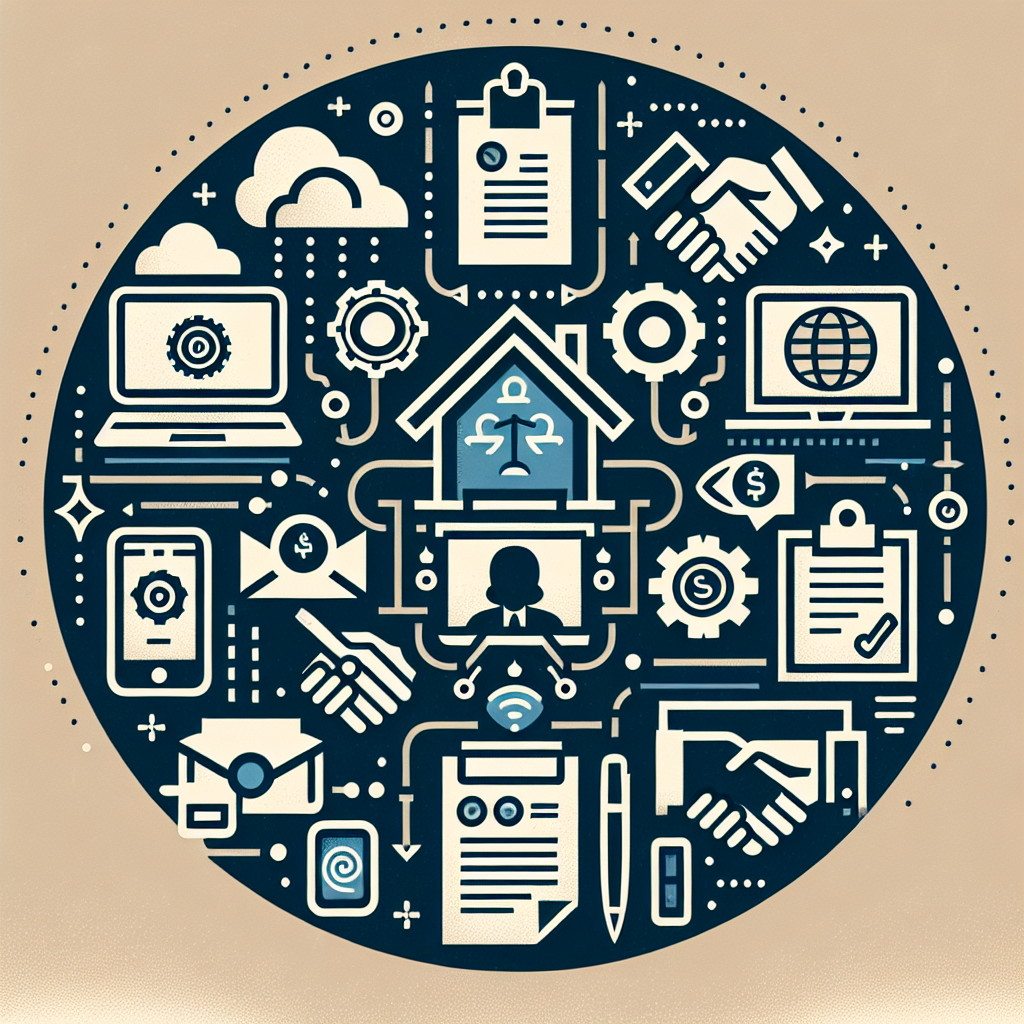Your cart is currently empty!
Tag: Managing

Best Practices for Drafting and Managing Service Level Agreements (SLAs)
A Service Level Agreement (SLA) is a contractual agreement between a service provider and their customer that outlines the level of service that will be provided. SLAs are essential for ensuring that both parties have a clear understanding of expectations and responsibilities.When drafting and managing SLAs, it is important to follow best practices to ensure that the agreement is effective and meets the needs of both parties. Here are some best practices for drafting and managing SLAs:
1. Define clear and measurable metrics: When drafting an SLA, it is important to define clear and measurable metrics that will be used to track the performance of the service provider. These metrics should be specific, relevant, achievable, and time-bound. By clearly defining these metrics, both parties will have a clear understanding of what is expected.
2. Include performance targets: In addition to defining metrics, it is important to include performance targets in the SLA. These targets should outline the level of service that is expected from the service provider. By including performance targets, both parties will have a clear understanding of what is expected and can work towards achieving these targets.
3. Include remedies for non-performance: It is important to include remedies for non-performance in the SLA. These remedies should outline what steps will be taken if the service provider fails to meet the agreed-upon performance targets. By including remedies for non-performance, both parties will have a clear understanding of the consequences of failing to meet the agreed-upon performance targets.
4. Regularly review and update the SLA: SLAs should be regularly reviewed and updated to ensure that they continue to meet the needs of both parties. By regularly reviewing and updating the SLA, both parties can ensure that the agreement remains relevant and effective.
5. Communication is key: Communication is key when managing SLAs. Both parties should communicate regularly to ensure that the agreement is being followed and that any issues are addressed promptly. By maintaining open and transparent communication, both parties can work together to ensure that the SLA is effective.
In conclusion, drafting and managing SLAs requires careful planning and attention to detail. By following best practices such as defining clear and measurable metrics, including performance targets, including remedies for non-performance, regularly reviewing and updating the SLA, and maintaining open communication, both parties can ensure that the agreement is effective and meets their needs.

Remote Monitoring for Environmental Sustainability: Monitoring and Managing Resources from Afar
Remote monitoring for environmental sustainability refers to the use of technology to monitor and manage resources from a distance. This innovative approach allows for the collection of real-time data on various environmental factors, such as air quality, water quality, and waste management, without the need for physical presence on-site.One of the key benefits of remote monitoring is its ability to provide accurate and up-to-date information on the state of the environment. By using sensors and other monitoring devices, environmental professionals can track changes in environmental conditions over time and identify potential issues before they escalate. This proactive approach to monitoring allows for timely interventions to be implemented, reducing the risk of environmental damage and ensuring the long-term sustainability of natural resources.
Remote monitoring also offers a cost-effective solution for monitoring and managing resources. By eliminating the need for constant on-site monitoring, organizations can save time and money while still maintaining a high level of environmental oversight. This can be particularly beneficial for remote or hard-to-reach locations where regular monitoring may be challenging or costly.
Furthermore, remote monitoring can help to improve the efficiency of resource management practices. By providing real-time data on resource usage and environmental impacts, organizations can make informed decisions about how to best allocate resources and reduce waste. This can lead to more sustainable practices that minimize the environmental footprint of operations and promote long-term sustainability.
In addition to its environmental benefits, remote monitoring can also have positive social and economic impacts. By ensuring the sustainable management of resources, organizations can help to protect the livelihoods of local communities and promote economic development. This can create a win-win situation where both the environment and local populations benefit from improved resource management practices.
Overall, remote monitoring for environmental sustainability is a powerful tool for monitoring and managing resources from afar. By leveraging technology to collect real-time data on environmental conditions, organizations can make informed decisions that promote sustainability and protect the environment for future generations. As we continue to face environmental challenges, remote monitoring offers a practical and effective solution for ensuring the long-term health and sustainability of our planet.

Tips for Successfully Managing Service Level Agreements in a Remote Work Environment
As remote work becomes increasingly common in today’s workforce, managing service level agreements (SLAs) in a remote work environment presents a unique set of challenges. However, with the right strategies in place, it is possible to successfully manage SLAs and ensure that service levels are consistently met. Here are some tips for effectively managing SLAs in a remote work environment:1. Set clear expectations: Clearly define the scope of work, deliverables, timelines, and key performance indicators (KPIs) for each SLA. Make sure that all team members understand their roles and responsibilities, as well as the expectations for meeting SLAs.
2. Use technology to track performance: Utilize project management tools and software to monitor progress, track performance metrics, and identify any potential issues or bottlenecks. This will help you stay on top of SLAs and address any issues in a timely manner.
3. Communicate regularly: Communication is key to successfully managing SLAs in a remote work environment. Schedule regular check-ins with team members to discuss progress, address any concerns, and provide feedback. Keep lines of communication open to ensure that everyone is on the same page.
4. Provide training and support: Ensure that team members have the necessary training, resources, and support to meet SLAs. Offer ongoing training and development opportunities to help team members improve their skills and performance.
5. Establish performance incentives: Consider implementing performance incentives or rewards for meeting or exceeding SLAs. This can help motivate team members to consistently deliver high-quality work and meet service level requirements.
6. Monitor and evaluate performance: Regularly review performance metrics and SLA compliance to identify trends, areas for improvement, and opportunities for optimization. Use data-driven insights to make informed decisions and continuously improve SLA management processes.
7. Adapt to changing circumstances: Be flexible and adaptable in your approach to managing SLAs in a remote work environment. Stay informed about industry trends, technological advancements, and best practices to ensure that your SLA management strategies remain effective and relevant.
By following these tips, you can successfully manage service level agreements in a remote work environment and ensure that service levels are consistently met. Effective SLA management is essential for maintaining customer satisfaction, improving operational efficiency, and driving business success in today’s remote work landscape.

Top Tools and Technologies for Managing IT Infrastructure
In today’s fast-paced and technology-driven world, managing IT infrastructure is crucial for businesses to stay competitive and efficient. With the increasing complexity and scale of IT systems, it’s important to have the right tools and technologies in place to effectively manage and monitor infrastructure.Here are some of the top tools and technologies for managing IT infrastructure:
1. Infrastructure Monitoring Tools: These tools provide real-time monitoring of network, server, and application performance to identify issues and bottlenecks before they impact users. Popular monitoring tools include Nagios, Zabbix, and SolarWinds.
2. Configuration Management Tools: These tools automate the process of configuring and managing servers, ensuring consistency and reducing the risk of human error. Tools like Puppet, Chef, and Ansible help streamline infrastructure management tasks.
3. Virtualization Technologies: Virtualization allows IT teams to create virtual instances of servers, storage, and networks, enabling greater flexibility and scalability. Leading virtualization technologies include VMware, Microsoft Hyper-V, and Citrix XenServer.
4. Cloud Management Platforms: With the increasing adoption of cloud services, cloud management platforms like AWS CloudFormation, Microsoft Azure Resource Manager, and Google Cloud Deployment Manager help organizations manage and automate their cloud infrastructure.
5. Containerization Tools: Containers provide a lightweight and portable way to package and deploy applications, making it easier to manage complex IT environments. Docker, Kubernetes, and OpenShift are popular containerization tools used for managing IT infrastructure.
6. Network Management Tools: Network management tools help IT teams monitor and troubleshoot network performance, security, and compliance. Tools like Cisco Prime Infrastructure, SolarWinds Network Performance Monitor, and ManageEngine OpManager are widely used for network management.
7. Database Management Tools: Managing databases is a critical aspect of IT infrastructure management. Tools like Oracle Enterprise Manager, Microsoft SQL Server Management Studio, and MySQL Workbench help IT teams monitor and optimize database performance.
8. Incident Management Tools: Incident management tools help IT teams track and resolve incidents and outages quickly and efficiently. Tools like ServiceNow, Jira Service Desk, and Zendesk provide a centralized platform for managing IT incidents.
9. Backup and Disaster Recovery Solutions: Data backup and disaster recovery are essential for protecting critical business data and ensuring business continuity. Popular backup and disaster recovery solutions include Veeam Backup & Replication, Commvault, and Acronis Backup.
10. IT Service Management (ITSM) Platforms: ITSM platforms help organizations streamline and automate IT service delivery and support processes. Leading ITSM platforms like ServiceNow, BMC Helix, and Freshservice help organizations manage IT infrastructure efficiently.
In conclusion, having the right tools and technologies for managing IT infrastructure is essential for ensuring the reliability, performance, and security of IT systems. By leveraging these top tools and technologies, businesses can effectively monitor, automate, and optimize their IT infrastructure to support their digital transformation initiatives.

Managing Customer Expectations in Technical Support: Best Practices and Tips
Technical support is an essential component of any business that offers products or services to customers. It is crucial for businesses to effectively manage customer expectations in technical support to ensure customer satisfaction and loyalty. By setting clear expectations and providing excellent service, businesses can build trust with their customers and create positive experiences that will keep customers coming back for more.Here are some best practices and tips for managing customer expectations in technical support:
1. Communicate clearly and effectively: It is important for technical support teams to communicate with customers in a clear and concise manner. This includes explaining technical issues in a way that is easy for customers to understand, setting realistic expectations for resolution times, and providing regular updates on the status of the issue.
2. Set realistic expectations: It is important to set realistic expectations for customers regarding the resolution of their technical issues. This may involve providing estimated resolution times, explaining the steps involved in resolving the issue, and being transparent about any potential challenges that may arise during the process.
3. Provide excellent customer service: Excellent customer service is key to managing customer expectations in technical support. This includes being responsive to customer inquiries, providing timely updates on the status of technical issues, and ensuring that customers feel valued and supported throughout the process.
4. Empower customers with self-service options: Providing customers with self-service options can help manage their expectations and reduce the need for direct technical support. This may include offering online resources, FAQs, troubleshooting guides, and other tools that customers can use to resolve common technical issues on their own.
5. Follow up and gather feedback: Following up with customers after a technical issue has been resolved is an important step in managing customer expectations. This allows businesses to ensure that the customer is satisfied with the resolution and gather feedback on their experience. This feedback can be used to improve the technical support process and address any areas for improvement.
In conclusion, managing customer expectations in technical support is essential for ensuring customer satisfaction and loyalty. By communicating clearly, setting realistic expectations, providing excellent customer service, empowering customers with self-service options, and following up with customers, businesses can build trust and create positive experiences that will keep customers coming back for more. By implementing these best practices and tips, businesses can effectively manage customer expectations in technical support and create a positive customer experience.

Managing Risk and Compliance with Managed Services
In today’s fast-paced and ever-changing business environment, managing risk and compliance has become a top priority for organizations of all sizes. With the increasing complexity of regulations and the growing threat of cyber attacks, companies are finding it more challenging than ever to ensure that they are meeting all of their legal and regulatory obligations.One solution that many companies are turning to is managed services. Managed services providers offer a range of services that can help organizations effectively manage risk and compliance, while also improving overall business operations. By outsourcing these functions to a third-party provider, companies can benefit from the expertise and resources of a dedicated team of professionals who specialize in risk management and compliance.
One of the key benefits of using managed services for risk and compliance is the ability to access specialized knowledge and skills that may not be readily available within the organization. Managed services providers have a deep understanding of the regulatory landscape and can help companies navigate complex compliance requirements with ease. They can also provide valuable insights and recommendations for improving risk management processes and reducing exposure to potential threats.
In addition, managed services can help companies streamline their risk and compliance processes, saving time and resources in the long run. By outsourcing these functions to a third-party provider, organizations can free up internal resources to focus on core business activities, while also benefiting from the efficiency and expertise of a dedicated team of professionals.
Managed services providers also offer a range of technology solutions that can help companies improve their risk management and compliance efforts. From advanced data analytics tools to sophisticated cybersecurity solutions, managed services providers can help organizations stay ahead of emerging threats and ensure that they are meeting all of their regulatory obligations.
Overall, managed services can be a valuable asset for companies looking to improve their risk management and compliance efforts. By outsourcing these functions to a third-party provider, organizations can benefit from specialized expertise, streamlined processes, and advanced technology solutions that can help them effectively manage risk and compliance in today’s complex business environment.

Best Practices for Managing Technical Support Tickets
Technical support tickets are a crucial aspect of any IT department or customer service team. They provide a structured way for users to report issues or request assistance, and they help ensure that all requests are addressed in a timely manner. However, managing technical support tickets can be a challenging task, especially as the volume of tickets increases. To ensure that your team is handling tickets effectively and efficiently, consider implementing the following best practices for managing technical support tickets:1. Prioritize tickets based on urgency and impact: Not all tickets are created equal, so it’s important to prioritize them based on their urgency and impact on the user or organization. Use a ticketing system that allows you to assign priority levels to tickets, and make sure your team is clear on the criteria for determining priority. This will help ensure that critical issues are addressed promptly, while less urgent requests can be handled in a timely manner.
2. Set clear SLAs and response times: Service Level Agreements (SLAs) are essential for managing technical support tickets, as they establish expectations for response times and resolution times. Make sure you have clear SLAs in place for different types of tickets, and communicate them to both your team and your users. This will help ensure that tickets are handled in a timely and efficient manner, and that users know what to expect in terms of support.
3. Use a centralized ticketing system: A centralized ticketing system is essential for effective ticket management, as it provides a single, organized platform for tracking and managing tickets. Make sure your team is using a ticketing system that allows for easy ticket creation, assignment, tracking, and resolution. This will help ensure that tickets don’t fall through the cracks and that all requests are addressed in a timely manner.
4. Implement automation and self-service options: Automation can help streamline the ticket management process by automating routine tasks, such as ticket routing and escalation. Consider implementing automation tools that can help your team prioritize and route tickets more efficiently. Additionally, offering self-service options, such as knowledge bases or FAQs, can help users resolve common issues on their own, reducing the number of tickets that need to be handled by your team.
5. Provide regular training and support for your team: Managing technical support tickets can be a demanding job, so it’s important to provide your team with the training and support they need to be successful. Make sure your team is well-trained on your ticketing system and processes, and provide ongoing support and feedback to help them improve their ticket management skills. Additionally, encourage collaboration and communication among team members to ensure that tickets are handled effectively and efficiently.
By implementing these best practices for managing technical support tickets, you can help ensure that your team is able to handle tickets effectively and efficiently, providing timely and high-quality support to your users. This will help improve user satisfaction, reduce ticket resolution times, and ultimately enhance the overall effectiveness of your technical support team.

Best Practices for Managing Service Level Agreements in a Remote Work Environment
As remote work becomes more prevalent in today’s workforce, businesses are faced with the challenge of managing service level agreements (SLAs) in a distributed work environment. SLAs are contractual agreements that outline the level of service that a provider will deliver to its customers, and remote work can complicate the monitoring and management of these agreements. However, with the right strategies in place, businesses can ensure that SLAs are met even in a remote work setting.One of the best practices for managing SLAs in a remote work environment is to establish clear communication channels. With team members working from different locations, it is crucial to have consistent and transparent communication to ensure that everyone is on the same page. This can include regular check-ins, virtual meetings, and the use of collaboration tools to track progress and address any issues that may arise.
Another important practice is to define key performance indicators (KPIs) that align with the SLAs. By setting specific metrics and targets, businesses can easily track performance and identify any areas that may need improvement. These KPIs should be communicated to all team members so that everyone understands their role in meeting the SLAs.
It is also essential to provide adequate training and support for remote workers. Working from home can present unique challenges, and employees may need additional resources or guidance to perform their tasks effectively. By investing in training programs and offering ongoing support, businesses can help remote workers meet SLAs and contribute to the overall success of the organization.
Additionally, businesses should consider implementing remote monitoring tools to track performance and ensure compliance with SLAs. These tools can provide real-time data on key metrics, allowing managers to identify any issues and take corrective action as needed. By leveraging technology, businesses can streamline the management of SLAs in a remote work environment and improve overall performance.
In conclusion, managing service level agreements in a remote work environment requires careful planning and communication. By establishing clear communication channels, defining KPIs, providing training and support, and leveraging technology, businesses can effectively monitor and manage SLAs in a distributed work setting. By following these best practices, businesses can ensure that remote workers meet SLAs and contribute to the success of the organization.

Best Practices for Managing IT Outsourcing Relationships
Outsourcing IT services has become a common practice for businesses looking to cut costs, enhance efficiency, and access specialized expertise. However, managing outsourcing relationships can be complex and challenging. To ensure smooth operations and successful outcomes, it is essential to follow best practices for managing IT outsourcing relationships.1. Establish clear communication channels: Effective communication is key to a successful outsourcing relationship. Clearly define roles and responsibilities, set expectations, and establish regular communication channels with the outsourcing partner. Regular meetings, progress updates, and feedback sessions can help keep everyone on the same page and address any issues or concerns in a timely manner.
2. Define clear goals and objectives: Before entering into an outsourcing agreement, it is essential to define clear goals and objectives for the project. Clearly outline the scope of work, deliverables, timelines, and performance metrics to measure the success of the outsourcing relationship. This will help align expectations and ensure that both parties are working towards the same goals.
3. Select the right outsourcing partner: Choosing the right outsourcing partner is crucial to the success of the project. Conduct thorough research, evaluate potential partners based on their experience, expertise, and track record, and ensure that they have the necessary resources and capabilities to meet your business requirements. A good fit between the organization and the outsourcing partner is essential for a successful collaboration.
4. Establish a strong governance structure: A well-defined governance structure is essential for managing an outsourcing relationship effectively. Establish clear roles and responsibilities, decision-making processes, and escalation procedures to address any issues or conflicts that may arise during the project. Regular performance reviews and audits can help ensure that the outsourcing partner is meeting the agreed-upon terms and delivering quality services.
5. Focus on building trust and transparency: Trust is the foundation of any successful outsourcing relationship. Build trust with the outsourcing partner by being transparent, honest, and open in your communication. Establish a culture of collaboration and teamwork, and work together towards achieving common goals. Trusting relationships are more likely to result in successful outcomes and long-term partnerships.
6. Monitor performance and quality: Regularly monitor the performance and quality of the outsourcing partner to ensure that they are meeting the agreed-upon service levels and delivering value to the organization. Establish key performance indicators (KPIs) and metrics to track progress, identify areas for improvement, and address any potential issues proactively. Regular performance reviews and feedback sessions can help ensure that the outsourcing relationship is on track and meeting expectations.
In conclusion, managing IT outsourcing relationships requires careful planning, effective communication, and a strong focus on collaboration and trust. By following best practices such as establishing clear communication channels, defining clear goals and objectives, selecting the right outsourcing partner, establishing a strong governance structure, focusing on building trust and transparency, and monitoring performance and quality, organizations can ensure successful outcomes and long-term partnerships with their outsourcing providers.

Business Continuity in a Global Economy: Strategies for Managing Supply Chain Disruptions and Market Volatility
In today’s global economy, businesses are facing unprecedented challenges when it comes to managing supply chain disruptions and market volatility. From natural disasters to political unrest to economic downturns, there are a multitude of factors that can impact a company’s ability to operate effectively and efficiently.Business continuity planning is essential for organizations looking to mitigate the risks associated with these disruptions and ensure resilience in the face of uncertainty. By developing a comprehensive strategy for managing supply chain disruptions and market volatility, businesses can better position themselves to weather the storm and emerge stronger on the other side.
One key aspect of business continuity planning is risk assessment. Businesses must identify and assess potential risks to their supply chain and market stability in order to develop effective strategies for managing and mitigating these risks. This can involve conducting thorough risk assessments, scenario planning, and stress testing to identify vulnerabilities and develop contingency plans.
Another important aspect of business continuity planning is building resilience into the supply chain. This can involve diversifying suppliers, developing alternative sourcing options, and implementing robust inventory management systems to ensure continuity of supply in the event of disruptions. By building redundancy and flexibility into the supply chain, businesses can better withstand unexpected shocks and disruptions.
In addition to supply chain resilience, businesses must also focus on managing market volatility. This can involve developing strategies for managing currency fluctuations, commodity price volatility, and geopolitical risks that can impact market conditions. By staying informed about market trends and developments, businesses can better anticipate and respond to changes in the business environment.
Communication is also key in managing supply chain disruptions and market volatility. Businesses must maintain open lines of communication with suppliers, customers, and other key stakeholders to ensure transparency and collaboration in times of crisis. By working together with partners and stakeholders, businesses can better coordinate response efforts and minimize the impact of disruptions on operations.
Overall, business continuity planning is essential for businesses operating in today’s global economy. By developing comprehensive strategies for managing supply chain disruptions and market volatility, businesses can better position themselves to withstand unexpected shocks and emerge stronger on the other side. By focusing on risk assessment, supply chain resilience, market volatility management, and communication, businesses can build resilience and agility into their operations, ensuring continuity and sustainability in the face of uncertainty.
